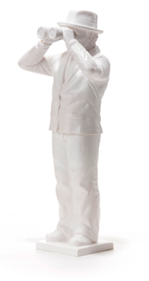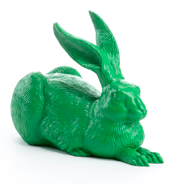
Ihr Warenkorb ist leer.


Ihr Warenkorb ist leer.

Welcome! Four thousand garden-dwarves dressed in black and white stretch out their hands to the visitors and bid them welcome to the Munich Opera Festival. Although they are only small, their appearance is appropriate, their presentation imposing, their choreography overwhelming. The visitors to the festival feel at home and smile back at the dwarves. Then, among the thousand-headed horde they discover a couple of anarchic exceptions, brightly coloured figures obscenely raising their middle fingers. A filthy gesture? A dwarves' revolt? A happening by Ottmar Hörl!
As unexpected and perplexing the parade of the dwarves might be for the visitors, it is an articulate expression of the artisitic method of its innovator and director - his "principle of organized anarchy" (Hörl 1982). Whether, as in his > Kuhprojekt < (Cow-Project, 1986), he clothed each of a small herd of cows with a well-fitting cover of transparent polyester, or he had a uniformed police-marksman fire two shots at the glazed front of the Historical Museum in Frankfurt (> By the way <, 1991), or whether he had a camera filming its own fall from a tower-block including its inevitable destruction on hitting the ground - in all of Hörl's works one encounters the contradiction of chaos and order, he always lays bare the structural elements of our material and social environment and thinks them through to their logical conclusion until, to use Dürrenmatt's words, events have taken the worst turn possible. In this way he is able to undermine the ceremonial monotony of the festival opening, to render apparent the natural parallel alignment of cows in the meadow and the danger that art becomes museumified and also the mechanical logic of the camera as man's extended arm and extended eye.[1]
[1] Thomas Knubben: Ottmar Hörl. Künstler – Kritisches Lexikon der Gegenwartskunst, Ausgabe 45, Heft 3, München 1999, p. 3
